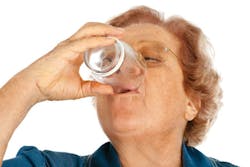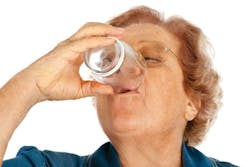The daily struggle with Sjogren's syndrome: Guiding dental patients to relief from pain
By Katie Melko, RDH, MSDH
What is Sjogren’s syndrome? “Sjogren’s syndrome is an autoimmune disease that affects the salivary and lacrimal glands which results in a decrease in saliva and tears.”1 The most common oral manifestation for Sjogren’s syndrome is xerostomia, another term for dry mouth.
The specific cause of Sjogren’s syndrome is unknown and currently has no cure. The cellular and humoral resistance are involved, and there are two types of Sjogren’s syndrome. Primary Sjogren’s syndrome is when the person only has one autoimmune disease, and secondary Sjogren’s syndrome is when the patient has a combination of another autoimmune disease.
Diagnosis
The authors of “Oral Pathology for the Dental Hygienist” state diagnosis is accomplished as: “Sjogren syndrome is identified when a patient presents themselves with xerostomia, keratoconjunctivitis sicca, and another type of autoimmune disease. A biopsy can be performed on one of minor salivary glands and a measurement of stimulated and unstimulated salivary flow; this information can help diagnosis Sjogren Syndrome. Keratoconjunctivitis can also be confirmed by having an eye examination and the lacrimal flow is measured with filter paper. Other symptoms that can be identified through blood work are mild anemia, decreased white blood cell count, an increase of serum Igs, and a prominent erythrocyte sedimentation rate. It is also said that ninety perfect of dental patients with this syndrome have a positive response to rheumatoid factor.”1
Treatment
Treatment options for Sjogren syndrome are usually based off of the symptoms patients have. Non-steroidal anti-inflammatory agents are used for arthritis. In more severe cases, corticosteroids and other immunosuppressive drugs can be utilized to give patients relief.
For dry eye relief, patients are using artificial tears and glasses to provide a protection to the eyes against wind. Patients suffer from dry mouth as well, and it can create many issues for the patients along with severe pain.1
Oral Manifestations
Patients will first experience xerostomia and that leads to the mucosa becoming erythematous. This results in dry lips that often crack which cause patients to complain of general discomfort in their mouth. The dorsum of the tongue loses filiform and fungiform papillae and is bright red in appearance.
Periodontal disease, high caries risk and oral candidiasis are general problems dental patients have with this autoimmune disease. Patients also experience painful fissures at the corners of the mouth (labial commissures), burning mouth, and sore mouth (mostly the tongue).
There are many treatment options available to help manage these issues and provide comfort to the patient simultaneously. The great thing is that there are multiple products to choose from; so, if one product doesn’t work, there are others to try. Using products that contain vitamin E are recommended, as well as lip balms and creams.
Treatment
The Journal of the American Medical Association states, “Reduction of salivary volume and subsequent loss of the antibacterial properties of saliva may accelerate infection, tooth decay, and periodontal disease.”2 Treatment options to help reduce this from happening are using saliva substitutes.
Many different options are on the market to help patients with dry mouth. There are tabs, nasal and oral sprays, lozenges, gum, toothpaste, mouthwash, gels, and chewables. Along with having multiple ways to help relieve dry mouth, there are also many different brand options. It is important to remember to tell your patients that a product takes a good seven days to show any signs of working. Patients usually try products on and off or for only a few days.
I would like to reiterate that even though there are many options to help patients; it takes time to reveal improvements with the oral health condition the patients have. Dental professionals can assist patients in finding what works best for them when it comes to dry mouth. Drinking water is great for the body. But if a patient with dry mouth is constantly drinking water, it does send a signal to the brain saying saliva isn’t needed. So I try to encourage my patients to not overdo it with water.
Biotene and Oasis are popular products that patients can easily purchase at any drug store. But I also recommend Xylimelts and sugar-free gum with xylitol. PreviDent Dry Mouth RX can be recommended when simpler remedies appear to be ineffective.
Other treatment options for patients who are having sores and burning sensation are borage seed oil (helps with inflammation and can be used as a soothing agent) and Orabase or any numbing aids that are sold in the oral health aisle (help reduce pain and burning sensation).
I have, unfortunately, have seen patients so desperate to alleviate the pain that they chew or place Tylenol directly on the area. This is why educating the patient on how to help alleviate the pain is important. Rincinol by Sunstar GUM is a great rinse that helps relieve pain. Orajel and Anbesol are other products my patients have used for temporary relief.
When patients have a flare-up of oral candidiasis or thrush, doctors often prescribe nystatin or Diflucan (the more popular options) to help relieve patients of pain.
Patient education
Saliva helps protect against periodontal disease and decay. The teeth are covered with a layer of saliva that helps fight against bacteria and saliva has antimicrobial agents that help kill the bacteria in the oral cavity. Saliva helps sweep away small bits of food that could have caused tooth decay by getting lodged in between the teeth or attaching to the tooth. Saliva has minerals that help remineralize the enamel.
Saliva can also help neutralize acids in the mouth during and after eating that break down tooth enamel. I recommended that patients who suffer from dry mouth use toothbased based on baking soda to help neutralize the pH of the saliva. A Delta Dental website adds, “Saliva also helps you digest food; it contains amylase that helps starches start to break down in your mouth. This help swallowing food easier by making it wet and soft so it can slide down your throat more easily.”3
Depending on the severity of the patient’s case, I usually recommended three to four month recalls for prophylaxis. The reason is to help reduce the amount of buildup and hopefully reduce root caries from developing, as well as to maintain the periodontal condition. I recommend a fluoride rinse and fluoride treatment in office to help remineralize and strengthen the tooth structure.
I also recommend that the patient at least rinse with water after every meal and brush twice a day and floss daily. Patients should avoid sugary based foods and drinks to help reduce decay.
Sjogren’s syndrome is disease that heavily effects the oral cavity. Educating the patients on the negative effects it can have will help minimize the damage of this autoimmune disease and hopefully provide comfort and pain relief. I have many patients who utilize diffusers, essential oils, and natural products to help reduce the amount of drugs they have to take, and I have seen some great results as well. As always let’s keep on fighting for our patient’s health and providing the best care we can! RDH
Katie Melko, RDH, MSDH, is a public health hygienist at Community Health Center Inc. She graduated from Fones School of Dental Hygiene at the University of Bridgeport in 2016 with an MSDH. She sits on three workgroups, two for ADHA and one for NBDHE, and has practiced dental hygiene since 2009.
References
1. Ibsen OAC, Phelan JA. 2009. Oral pathology for the dental hygienist. St. Louis, Mo: Saunders/Elsevier.
2. http://jamanetwork.com/journals/jamainternalmedicine/fullarticle/217138
3. http://oralhealth.deltadental.com/Adult/GeneralInformation/22,DD205
4. Wilkins EM. 2009. Clinical practice of the dental hygienist. Philadelphia: Wolters Kluwer Health/Lippincott Williams & Wilkins.
5. www.hopkinssjogrens.org
6. http://www.sjogrens.org

